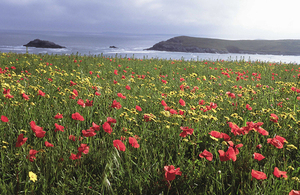First successful breeding record of ospreys at National Nature Reserve
A pair of rare ospreys have successfully raised two male chicks on Natural England’s Roudsea Wood and Mosses National Nature Reserve in South Cumbria, the organisation announced today.

It is the first time that a pair of ospreys have nested on one of Natural England’s National Nature Reserves and it is hoped that the birds – which tend to be faithful to a nest site - will return to breed at Roudsea Wood and Mosses NNR in future years and raise many more young. There has been a record of six reported breeding pairs of ospreys throughout Cumbria this year, which is the highest number since the bird returned to breed in England in 2001.
The Roudsea birds attempted to build a nest on a nearby electricity pylon last year, just outside the reserve. This blew down during last winter’s storms and Electricity North West eagerly offered to fund the construction of a new nesting platform in the nature reserve, on top of a 30 metre-tall Scots pine tree, and within sight of good viewing positions on the reserve. The platform was erected on the 17 March 2014 and by the 2 April the newly arrived ospreys had adopted the platform and were already starting to build their nest.
Little is yet known about the parents – many breeding osprey in England are ringed to help track their movements and support conservation efforts but Roudsea’s breeding female bird is unringed, and could have come from Scotland or Scandinavia. She will soon start her return migration to Africa, whilst dad will remain for the next few weeks to make sure his offspring know how to fish, before they too return south.
Roudsea Wood and Mosses National Nature Reserve in South Cumbria is one of the most important wildlife sites in England. An extensive mosaic of ancient woodlands, raised bogs, fens, reedbeds and saltmarsh provide habitat for a range of species including otter, kingfisher, dormouse, several species of rare butterfly and insects. Visitors to the reserve, have had unbridled views in the last few weeks of the attentive parents, catching and bringing in fish, including mullet to feed the hungry and fast developing young.
Rob Petley Jones, Natural England’s Senior Reserve Manager at Roudsea Wood and Mosses National Nature Reserve said; “We are overjoyed at their breeding success - It’s been brilliant to watch the family’s progress. We’ve worked hard here for many years to manage the site for wildlife and feel rewarded that the conditions are right to encourage these rare birds to nest here. We’ve all been keeping our fingers crossed that the birds would return after last year’s initial nesting attempt, and it was great to have the enthusiastic support from Electricity North West who funded the construction of the new platform. Visitors to the reserve have also been fascinated with views of the male bird regularly bringing back huge flapping fish for his mate and their growing offspring. We look forward to welcoming them back again next year.”
Daniel Garner, delivery manager for Electricity North West, said: “We were delighted to be able to help Natural England by sponsoring the new Osprey nesting platform at Roudsea Wood and Mosses National Nature Reserve. These amazing birds previously nested on a nearby electricity pylon, which could have potentially caused issues if our engineers needed to carry out maintenance work, so it was important that we offered them a safe alternative. We’re looking forward to welcoming the ospreys back next year and will continue to assist Natural England in any way we can.”
Natural England also has plans to install a webcam and improve access at the reserve for people to view the birds if they return next year. 2015 will also mark the Diamond Jubilee for the reserve.
Ends
For more information (media only) contact Natural England’s press office: Emma Lusby, emma.lusby@naturalengland.org.uk / 0300 060 4231 / 07900 608073
About ospreys
Ospreys became extinct as a breeding bird in England in 1840 and did not return until 2001. Today, there are between 200 and 250 pairs of breeding osprey in Britain, but most of these are in Scotland, where it recolonized in 1954. There are also a small number of breeding pairs in Rutland Water and Kielder Forest, Northumberland. They visit the UK from Africa to breed in late March, before making the return journey in September. They feed exclusively on fish, which they catch with impressive dives into the water.
About Roudsea Woods and National Nature Reserves
Most of Natural England’s National Nature Reserves are free and open to the public. Natural England lease Roudsea Woods from the Holker Estate, and a permit to visit this nature reserve is required. This is available from Rob Petley-Jones, Senior Reserves Manager: rob.petley-jones@naturalengland.org.uk. Natural England is drawing up plans to improve access for those wanting to view the birds when they hopefully return next year.
National Nature Reserves are some of the very finest sites in England for wildlife and geology, and provide great opportunities for people to experience nature. They have been established to protect and manage the special wildlife habitats, species and geological features that occur there. These features are of national and often international importance, and many NNRs are important for study and research. Almost all NNRs have some form of access provision – many are fully open throughout the year. There are 224 throughout England.